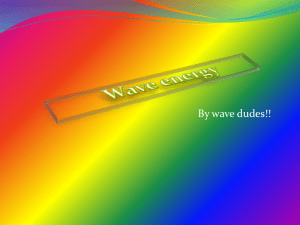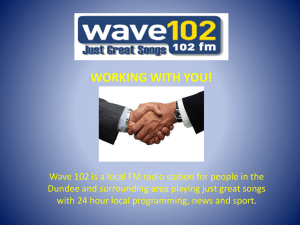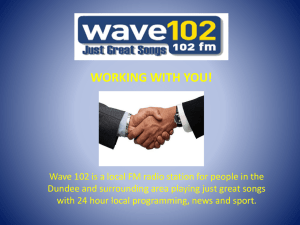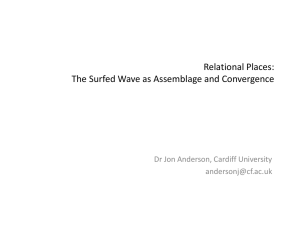Powerpoint
advertisement
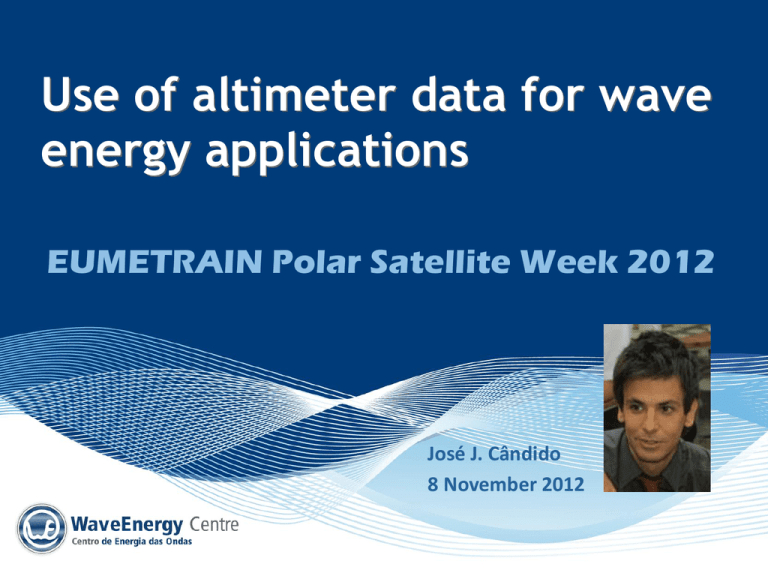
Use of altimeter data for wave energy applications EUMETRAIN Polar Satellite Week 2012 José J. Cândido 8 November 2012 The Wave Energy Centre - Who we are Energy companies • Founded in 2003 as a private non-profit association • Devoted to the development & promotion of offshore renewable energy • 14 Associates from different sectors Research institutions Engineering companies and developers The Wave Energy Centre - Our goal Implementation of Offshore Renewable Energy Industry through: Technical, logistic and strategic support to companies Identification and mitigation of main technological and nontechnological barriers Cooperation with all relevant stakeholders The Wave Energy Centre - Six main core areas Technologies Evaluation & Feasibility Studies Dissemination, Training & Public Outreach Monitoring & Operational Support Strategic Policy & Economy Numerical Modelling Environmental Strategy & Monitoring The Wave Energy Centre - R&D projects 2008 2009 2010 2011 2012 2013 2014 2015 CORES - Components for Renewable Ocean Energy Systems EQUIMAR - Equitable testing and evaluation of marine energy extraction devices in terms of Performance, Cost and Envir. Impact WAVETRAIN2 - Multinational Initial Training Network on Wave Energy (Coord: WavEC) 13 EU grants & 3 national grants AquaRET2 - Aquatic Renewable Energy Technologies SURGE - Simple Underwater RE Generation of Elect. WAVEPORT - Demo. & Deployment of a Commercial Scale Wave Energy Converter with an innovative Real Time Wave by Wave Tuning System ORECCA - Off-shore Renewable Energy Conversion platforms SOWFIA - Streamlining of Ocean Wave Farm Impacts Assessment FAME - Future of the Atlantic Marine Ocean KIC Innoenergy Project ‘Offshore Test Station’ DEMOWFLOAT - Demonstration of the WindFloat Technology MARINET - Marine Renewables Infrastructure Network for Emerging Energy Technologies TROPOS - Modular Multi-use Deep Water Offshore Platform Harnessing and Servicing Mediterranean, Subtropical and Tropical Marine and Maritime Resources WEAM - Wave Energy Acoustic Monitoring (Coord: WavEC) Road-map - Roadmapping Offshore Renewables in Portugal Offshore RE Technologies Observatory Linear wave theory Irregular sea surface = Infinite sum of sinusoidal components Directional wave spectrum S(f,) distribution of energy density in frequency and direction 2 S( f ) S( f , )d 0 Frequency spectrum S(f) distribution of energy density in frequency Characterization of sea waves Wave parameters 2 mn f nS(f , )dfd n-th spectral moment 0 0 1/2 Hm 4m0 0 Hs significant wave height 1/2 Tm02 m0 m2 Tz mean zero-crossing period Characterization of sea waves (cont.) Wave parameters m1 Te m0 Tp P 1 fp 2 0.5Hs Te mean energy period peak period wave power (deep waters) (in kW/m when Hs in m and Te in s) Characterization of sea waves (cont.) Wave parameters mean wave direction 2 arctan 20 0 arctan 0 00 0 S(f , ) sin( )ddf S(f , ) cos( )ddf S(f ) sin( (f ))df S(f ) cos( (f ))df Wave data sources Datawell Directional Waverider ASAR ScanSAR Wave Mode Teledyne RD Instruments Workhorse Sentinel ADCP WAM model (National & Kapodistrian University of Athens) TOPEX/Poseidon (AVISO) Satellite altimetry timeline • 1969 - Space oceanography by radar instrumentation as a new discipline (congress of Williamstown) • 1973 - Skylab (USA's first experimental Space station) launched in May; first spaceborne altimeter - measurement of coarse features of the marine geoid • 1975 - GEOS 3 (Geodynamics Experimental Ocean Satellite) launched in April; improved performance and greater global coverage - measurements of sea level and its variability over time • 1978 - Seasat (SEAfaring SATellite) launched by NASA in June; first high-performance altimeter for remote sensing of the oceans - measured ocean surface and wave heights; mission ended in October 1978, due to malfunction • 1985 - Geosat (GEOdetic SATellite) launched in March; first mission to provide long-term high-quality altimetry data (>3yrs) • 1991 - ERS-1 launched by ESA in July; successively implemented on 3 different orbits, containing several instruments including a radar altimeter • 1992 - TOPEX/Poseidon (joint project between NASA and CNES) launched on 10 August; it carried two radar altimeters and precise orbit determination systems (including DORIS ); laid foundation for long-term ocean monitoring from Space; supplied world's ocean topography and sea surface height every ten days with high accuracy • 1995 - ERS-2 (ERS-1 follow-on) launched in April • 1998 - GFO (Geosat follow-on) launched in February Satellite altimetry timeline (cont.) • 2001 - Jason-1 (TOPEX/Poseidon follow-on) launched on 10 December (CNES and NASA); satellite control and data processing operations performed by new ground segment • 2002 - Envisat (Environmental Satellite, ERS-1 and ERS-2 follow-on) launched by ESA on 1 March; carries ten complementary instruments including radar altimeter and DORIS orbitography and precise location system; offers near-real-time data access • 2008 - Jason-2 launched on 20 June (CNES, NASA, Eumetsat and NOAA); takes over and continues TOPEX/Poseidon and Jason-1 missions; carries Poseidon-3 - next generation of Poseidon altimeter with lower instrument noise and algorithm enabling better tracking over land and ice; ~2.5 cm accuracy altimeter measurements • 2010 - Cryosat-2 launched on 8 April (ESA); altimetry satellite dedicated to polar observation - determines variations in the thickness of the Earth's continental ice sheets and marine ice cover, tests prediction of thinning Arctic ice due to global warming; current plans to operate over oceans for validation purposes in low-resolution mode • 2011 - HY-2 (HaiYang means 'ocean' in Chinese) launched in August (China); monitors sea surface wind field, sea surface height and sea surface temperature measurement accuracy (credits CNES) TOPEX/Poseidon • 1981 - CNES evaluates Poseidon altimeter to be carried onboard the first Spot satellite; NASA plans TOPEX (Topography Experiment) mission to follow Seasat’s success • 1983 - Insufficient individual budgets: CNES and NASA begin discussing possibility of combining the two projects • 1987 - CNES and NASA formally create partnership for joint project involving French and American instruments, on an American satellite to be launched by a European rocket (Ariane 4): TOPEX/Poseidon TOPEX/Poseidon Launch End Date Altitude Inclination 66° Repetitivity Agency Frequencies Improvements to previous altimetry systems: specially-designed satellite, suite of sensors, satellite tracking systems and orbit configuration, development of optimal gravity model for precision 9.9156 days orbit determination and dedicated ground system for NASA/CNES mission operations TOPEX: 13.6 GHz - Ku band 5.3 GHz - C band Poseidon: 13.6 GHz – Ku band 10/08/1992 8/01/2006 1336 km • 2002 - On 15 September TOPEX/Poseidon assumed a new orbit midway between its original ground tracks; the former TOPEX/Poseidon ground tracks are now overflown by Jason-1 (this tandem mission demonstrated the scientific capabilities of a constellation of optimized altimetry satellites) • 2005 - October, last data acquired, due to failure in a pitch reaction wheel Altimetry basic principle Altimetry satellites - distance from satellite to target surface by measuring satellite-tosurface round-trip time of a radar pulse Satellite orbit accurately tracked (DORIS, PRARE, GPS; laser tracking - calibration); position determined relative to arbitrary reference surface - ellipsoid; sea surface height (SSH) - range from sea surface to reference ellipsoid Water vapour , electrons in the atmosphere, sea state … can affect the radar signal round-trip time, distorting range measurements – interference correction: supporting measuring instruments, several different frequencies, modelling Magnitude and shape of echoes (or waveforms) - characteristics of reflecting surface: wave height and wind speed over the oceans, backscatter coefficient and surface roughness for most reflecting surfaces; best results over ocean - spatially homogeneous, surface conforms with known statistics Non-homogeneous surfaces, containing discontinuities or significant slopes (some ice, rivers or land surfaces) - accurate interpretation difficult Different frequencies used (+ and -) Ku-band: sensitivity to atmospheric perturbations Ka-band: better observation of ice, rain, coastal zones, land masses Comparison between different frequency signals generate interesting results (rain rate over the oceans, detection of crevasses over ice shelves, etc) Altimetry requires great amount of information to be taken into account before being able to use the data Data processing is a major part of altimetry, producing data of different levels for different uses Radar altimeter data ● Significant wave height - Hs (accuracy comparable to that of in situ measurements) Wind speed at 10 m height - U10 Backscatter coefficient - σ0 ● Wave period - Proposed algorithms: Relating σ0 with probability distribution of sea surface slopes → variance of the slopes in terms of spatial spectral moments → dispersion relationship: convert into temporal spectral moments → estimate of 1 m4(σ0), m0=Hs2/16 → altimeter characteristic wave period m 2 Davies et al. (1997) - Tz a bTA c dTA eTA2 f 2 TA 0 m4 g 2H s 2 3.25 U10 0.31 pseudo wave age Hwang et al. (1998) - Tp and Tz (more suitable for closed sea, where swell is less dominant) Gommenginer et al. (2003) - linear relationship between Tz and (σ00.25Hs0.5) based on buoy observations 2 0.25 0l radar cross-section at Ku band in its linear form Tz 0.895 2.545( 0l Hs ) Quilfen et al. (2004) - neural network to establish Tz(σ0, Hs); two algorithms: 1 Ku band: Tz exp(17.1642a 13.5844), a 1 exp(0.6573Hs 0.1084 0Ku 02962 2.2377) Ku and C bands: 0Ku 0.3082 2 Tz exp(5.7474 1.4688a 1.7943b), a exp( 1 . 5068 b ), b 1 1 exp(1.8612 0.08U10 ) 0C 0.2352H s 0.0981 Radar altimeter data (cont.) ● Wave period - Proposed algorithms (cont.): Kshatriya et al. (2005) - empirical algorithm Tz(ξ, TA) Tz a b cT A dTA e 2 fTA2 , a 0.1130, b 0.6090, c 2.4369, d 0.0045, e 0.0487, f 0.2270 Mackay et al. (2008b) - two-piece Tz model (Ku band); threshold level ~13 dB above which σ0 is no longer related to Tz 1 ln 1 0 A if 0 H s Tz , 1 1 A if 0 ln H s A 17.11, 4.504, 0.1558, 1.658, 12.87 for TOPEX Radar altimeter data validation Co-location criteria – Space and time lags TOPEX/Poseidon Quasi-polar, non-sun-synchronous orbit 66ºN - 66ºS coverage 9.9156 days repeat cycle (5 days for tracks intersections) 127 revolutions, 254 passes per cycle 315 km ground track separation at Equator Buoys: Wave spectra every 3 hours (every 30 min, Hs>5 m) 20 min records Criteria: Minimum space lag Maximum space lag Average criterion Time interpolation Space interpolation Monthly averages Group velocity criterion Radar altimeter data validation - Hs & Tz Moreira et al. (2002) TOPEX/Poseidon 4 buoys off the west coast of Portugal 83 - 110 m depths Sep 1992 - Dec 1999 (1995 on for Tz) 10 - 50 km minimum space lags ▪ Average criteria reduces errors; ▪ Hs: Erms < 0.3 m, r2 up to 0.98; ▪ Local calibrations recommended; ▪ Tz: Davies et al. Erms < 0.7 s with local coeffs. Radar altimeter data validation - Hs & Tz in Zhao Dongliang et al. (2012) NDBC buoys 2001 – 2005 Satellite footprint within 50 km Time lag < 1 h 3236 group data in Cruz et al. (2007) Mackay et al. (2008b) TOPEX & NDBC buoy data T02: Erms = 0.6 s Radar altimeter data validation - Tz Pontes et al. (2009) Quilfen et al. (2004) - Ku & C bands Jason NDBC buoys data Jul-Dec 2005 36 km maximum space lag 30 min maximum time lag 640 group data Radar altimeter data validation - Hs, Tz, Te & P M. Teresa Pontes, M. Gonçalves, J. Cândido (2002) - INETI Empirical algorithm deduced from buoy measurements off the north-west coast of Portugal Te 1.1509Tz 1.0882 whole set < 100 kW/m TOPEX/Poseidon vs. buoy data Figueira da Foz off Portugal NW coast Radar altimeter data validation and utilization - P Pontes et al. (2002) Track 126 P (T/P) = 18.1 kW/m P (WAM) = 13.5 kW/m Track 239 P (T/P) = 19.8 kW/m P (WAM) = 14.9 kW/m TOPEX/Poseidon ECMWF WAM model Rio de Janeiro off Brazil coast 1999-2001 Radar altimeter data validation - Tz & Te Te=1.36Tz Te=1.15Tz Radar altimeter data validation and utilization - Te & P Mackay et al. (2008b) Algorithm to estimate T-10 from Ku-band altimeter data (jointly developed by OPD and NOCS) with Erms≈1.0s Mean Pelamis WEC power 2ºx2º grid Global database of altimeter measurements – 6 missions spanning 14 yrs Mackay et al. (2008a) Along track mean Pelamis WEC power TOPEX/Poseidon & Jason phase A data Sep 1992 - Sep 2006 Monthly Annual Erms=34.3kW Erms=15.5kW Mean Pelamis WEC power 2ºx2º square 10 yrs altimeter and NDBC buoy measurements Erms for along track mean Pelamis WEC power Radar altimeter data utilization Fugro OCEANOR Provides metocean data and software packages to the oil, coastal engineering, renewables and other marine industries Several different products: WorldWaves global offshore database Global database – wind and wave time series data ECMWF models calibrated against satellite data in situ buoy data where available 0.5º grid; 6 hrs 1996 to date Global summary of the WorldWaves model vs. satellite correlation coefficient (for all validation grid points) ECMWF WAM model data calibration by Fugro OCEANOR against global buoy and TOPEX database Correlation coefficient between simultaneous co-located WorldWaves and TOPEX-Jason Hs Jan 1997- Dec 2006 Radar altimeter data utilization (cont.) Fugro OCEANOR World Wave Atlas Series of wind and wave atlases primarily based on satellite altimeter data - wind and wave climate statistics worldwide: ▪ Geosat (1986 - 1989) ▪ Topex-1 (1992 - 2002) ▪ Topex-2 (Sep 2002 –-2005) ▪ Jason-1 (Jan 2002 - 2008) ▪ EnviSat (Oct 2002 – present, ongoing) ▪ Geosat Follow-On (GFO) (Jan 2000 – 2008) ▪ ERS-1 (1991 - 1996) ▪ ERS-2 (1995 - ) ▪ Jason-1n (2008 - ongoing) ▪ Jason-2 (2008 – ongoing) Mean Hs along TOPEX/Jason ground tracks off Western Europe Hs and wind speed made ~ each 6 km along tracks each satellite passing Comparison of TOPEX data and simultaneous buoy Hs Satellite data validation: data set of co-located NOAA buoy and TOPEX data 13 buoys 1365 data records Data from tracks passing within 100km and 1h with respect to buoy observations Radar altimeter data utilization (cont.) Fugro OCEANOR - Barstow et al. (2009) Simple Coastal Wave Modelling Use of satellite data together with long-term offshore WorldWaves model data to estimate the coastal wave energy resources Satellite passes from offshore to nearshore → measures Hs profile with along-track resolution of ~6km TOPEX: Hs profiles from deep offshore to coast ~every 10 days over 10-year period Adjust offshore grid point data to various points along the satellite tracks → reasonably accurate wave height statistics closer to the coast (although data will be spatial average over altimeter footprint) Satellite flying towards SE Sep - Nov wave energy resource along Norwegian Along-track mean Hs (north of Ireland) → estimate long-term wave statistics closer to the coast Radar altimeter data utilization - Wave model data validation ERA-40 WAM model vs. TOPEX/Poseidon - J. Cândido, M.T. Pontes, L. Gato Conclusions • Satellite altimeter estimates of Hs accuracy comparable to the one of in situ measurements • Several models proposed to estimate Tz from altimetry data with very reasonable precision • Assessment of wave energy resource in deep waters requires the knowledge of Te - algorithms insufficiently accurate • Use of altimeter data suitable for: - Preliminary wave energy resource assessment purposes - Validation of wave model data used in wave energy resource assessment studies - Integrating wave atlases - complementary data; extrapolation of existing data References Barstow, S., G. Mork, L. Lonseth, J.P. Mathisen, 2009. WorldWaves wave energy resource assessments from the deep ocean to the coast. Proc. EWTEC 2009: 8th European Wave and Tidal Energy Conference. Uppsala, Sweden. Cruz, J., E. Mackay, T. Martins, 2007. Advances in Wave Resource Estimation: Measurements and Data Processing. Proc. EWTEC 2008: 7th European Wave and Tidal Energy Conference. Davies, C.G., P.G. Challenor, and P.D. Cotton, 1997: Measurement of wave period from radar altimeters, in Ocean wave measurement and analysis, edited by B.L. Edge, and J.M. Hemsley, pp. 819-826, Am. Soc. Civil Eng, Virginia, USA, 1997. Gommenginger, C.P., M.A. Srokosz, P.G. Challenor, 2003. Measuring ocean wave period with satellite altimeters: a simple empirical model. Geophysical Research Letters, 30(22): 2150, doi: 10.1029/2003GL017743. Hwang, P.A., Teague, W.J., Jacobs, G.A. and Wang, D.W., 1998: A statistical comparison of wind speed, wave height, and wave period derived from satellite altimeters and ocean buoys in the Gulf of Mexico region. J. Geophys. Res., vol.103, No. C5, 10451-10468, May 15. Mackay, E.B.L., A. Bahaj, C.H. Retzler, P.G. Challenor, 2008a. Wave energy resource assessment using satellite altimeter data. Proc. International Conference on Offshore Mechanics and Arctic Engineering, OMAE2008, vol. 6, pp. 861-870. Mackay, E.B.L., C.H. Retzler, P.G. Challenor, C.P. Gommenginger, 2008b. A parametric model for ocean wave period from Ku band altimeter data. Journal of Geophysical Research, 113: C03029, doi: 10.1029/2007JC004438. Moreira, N., H.O. Pires, M.T. Pontes, C. Camara, 2002. Verification of TOPEX/Poseidon Wave Data against Buoys off the West Coast of Portugal. Proc. 21st International Conference on Offshore Mechanics and Arctic Engineering, OMAE2002, Oslo, Norway. Pontes, M.T., M. Goncalves, J. Cândido, 2002: Preliminary Assessment of Wave Energy Resource in Brazil and Wave Energy Plant in Leblon Beach. INETI Report. June. Pontes, M.T., M. Bruck, S. Lehner, 2009. Assessing the wave energy resource using remote sensed data. Proc. EWTEC 2009: 8th European Wave and Tidal Energy Conference. Uppsala, Sweden. p. 111-116. References (cont.) Quilfen, Y., B. Chapron, M. Serre. 2004. Calibration/validation of an altimeter wave period model and application to TOPEX/Poseidon and Jason-1 altimeters. Marine Geodesy, 27(3): 535-549. Zhao Dongliang, Li Shuiqing, Song Chaoyang, 2012. The comparison of altimeter retrieval algorithms of the wind speed and the wave period. Acta Oceanol. Sin., Vol. 31, No. 3, P. 1-9. DOI: 10.1007/s13131-012-0201-4. AVISO: www.aviso.oceanobs.com Fugro OCEANOR: www.oceanor.no www.altimetry.info


